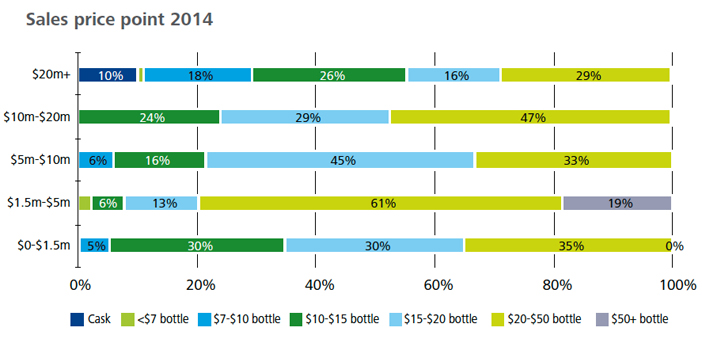Wine as a business: the numbers behind commercial wine making


Wine Technology takes a look at some of the key metrics that wineries need to achieve to be successful in commercial wine making.
‘Vintage 2014: New Zealand wine industry benchmarking survey’ – a joint publication from Deloitte and New Zealand Winegrowers, published in December 2014, indicated some interesting trends in the commercial wine making industry:
Size matters: larger wineries yield greater profit percentages
Profitability increases with winery size. Wineries with annual sales revenue of up to $1.5m made an average of 3.3% profit (before tax) in 2014. Wineries of this size achieved an average gross margin of 33.1%.
Yet the large wineries of $20m+ annual revenue made a 17.6% profit (before tax) in 2014. Their average gross margin was 44.8%.
This trend is nothing new in the NZ wine industry: small wineries struggle to achieve profitability; it needs size and economies of scale to make good money.
What gross margin does a winery need to achieve to be profitable?
A winery needs to achieve a gross margin of around 40% for the business to be sustainable and make decent profit levels. That means that overheads must consistently be reviewed and managed to ensure that the bottom line is profitable.
Wine packaging costs
Packaging costs are a significant cost that commercial wineries need to manage; this involves the bottles, closures, labels and boxes – plus an investment in graphic design to ensure that the packaging is attractive and appropriate to the target market.
In 2014, wineries spent between $9.15 and $23.65 on packaging per case of wine. Winery size has a big influence on the costs, as it’s far more economical to have large print runs, which really brings down the wine packaging prices.
What’s the price of a bottle of NZ wine?
Or, rather, what’s the retail price achieved by NZ wineries selling their products here in New Zealand?
Anyone who’s ever been in a bottle shop in New Zealand knows that the price range of kiwi wine varies dramatically.
As the chart below shows, the smaller and more boutique wineries focus on the mid-to-high range. They need to charge high prices, in order to have some degree of profitability in their business. After all, they have a lower volume of wine to sell, so they need to make as much money as possible from their yield.

Source: ‘Vintage 2014: New Zealand wine industry benchmarking survey’ – a joint publication from Deloitte and New Zealand Winegrowers, December 2014.
Likewise, it’s the larger wineries targeting the cheaper and cask end of the market – they have the economies of scale to be able to do this. The small wineries simply can’t afford to compete in this space.
Summary
- Profitability increases with winery size.
- A winery needs to achieve a gross margin of around 40% for the business to be sustainable and make decent profit levels.
- In 2014, wineries spent between $9.15 and $23.65 on packaging per case of wine.
- Winery size has a big influence on the costs: the larger wineries benefit from economies of scale.
- Smaller wineries tend to focus on mid-to-high priced products. They have a lower volume of wine to sell, so need to make as much money as possible from their yield to cover their costs.
- Larger wineries are targeting the cheaper and cask end of the market.
Source: ‘Vintage 2014: New Zealand wine industry benchmarking survey’ – a joint publication from Deloitte and New Zealand Winegrowers, December 2014.
